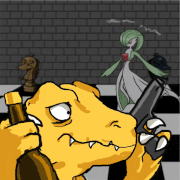|
Dalael posted:I'm one of the guys who would totally have underestimated slingers and died from having been hit smack in the face. The good news is as a youth you would have probably been familiar with them for killing small birds and mammals.
|
|
|
|

|
| # ? May 15, 2024 04:49 |
|
bewbies posted:this is interesting as hell Xenophon really liked slingers quote:They had not proceeded far when Mithradates appeared again, accompanied by about two hundred horsemen and by bowmen and slingers--exceedingly active and nimble troops--to the number of four hundred. He approached the Greeks as if he were a friend, but when his party had got close at hand, on a sudden some of them, horse and foot alike, began shooting with their bows and others with slings, and they inflicted wounds. And the Greek rearguard, while suffering severely, could not retaliate at all; for the Cretan bowmen not only had a shorter range than the Persians, but besides, since they had no armour, they were shut in within the lines of the hoplites; and the Greek javelin-men could not throw far enough to reach the enemy's slingers. quote:Hence, if we should propose to put an end to the possibility of their harming us on our march, we need slingers ourselves at once, and horsemen also. Now I am told that there are Rhodians in our army, that most of them understand the use of the sling, and that their missile carries no less than twice as far as those from the Persian slings. For the latter have only a short range because the stones that are used in them are as large as the hand can hold; the Rhodians, however, are versed also in the art of slinging leaden bullets. If, therefore, we should ascertain who among them possess slings, and should not only pay these people for their slings, but likewise pay anyone who is willing to plait new ones, and if, furthermore, we should devise some sort of exemption for the man who will volunteer to serve as a slinger at his appointed post, it may be that men will come forward who will be capable of helping us. quote:When he got near the Greeks, he stationed some of his battalions in their rear and moved others into position on their flanks; then, although he could not muster up the courage to close with them and had no desire to risk a decisive battle, he ordered his men to discharge their slings and let fly their arrows. But when the Rhodian slingers and the bowmen, posted at intervals here and there, sent back an answering volley, and not a man among them missed his mark (for even if he had been very eager to do so, it would not have been easy), then Tissaphernes withdrew out of range with all speed, and the other battalions followed his example. Xenophon was kind of weird for a Greek general because he loved cavalry and missile units, but then he learned a lot of hard lessons on their value in Asia.
|
|
|
|
Silver2195 posted:It's discussed here (though it should go without saying that you should take the conclusions with a grain of salt): http://hwlabadiejr.tripod.com/roma.htm Good find!
|
|
|
|
Squalid posted:Xenophon really liked slingers And if you look at the trajectory of greek military history he was 100% correct. By the time of Philip II the macedonian army relied heavily on both cavalry and light infantry/archers.
|
|
|
|
FAUXTON posted:Istanbul's secret name is Chicago That's a strange way to pronounce "New Jersey."
|
|
|
|
Huh. I would toss apples across campus in high school with a sling. Didn’t think they would toss fist sized stones. That’s solid bone smashing range on bigger bones.
|
|
|
|
Ein Sexmonster posted:And if you look at the trajectory of greek military history he was 100% correct. By the time of Philip II the macedonian army relied heavily on both cavalry and light infantry/archers. The Romans did too, they just had the same biases as Greeks that missile weapons were for unmanly cowards and real Roman Men fought hand to hand, so they don't get mentioned much. But they were always an important part of battle.
|
|
|
|
Grand Fromage posted:The Romans did too, they just had the same biases as Greeks that missile weapons were for unmanly cowards and real Roman Men fought hand to hand, so they don't get mentioned much. But they were always an important part of battle. I wonder if they would have kept feeling this way if longbows (like those used at Agincourt) had been introduced then.
|
|
|
|
Dalael posted:I wonder if they would have kept feeling this way if longbows (like those used at Agincourt) had been introduced then. They just really didn't care. It's a good bet that at one point a Roman siege engineer took the time to prototype a handheld ballista with serious armor piercing potential, and also a good bet that they treated it like a silly toy and used it to shoot olives into each other's mouths. Because to them, it just was...not how it was supposed to be. Cultural prejudices play a big part in how a society chooses to make war. Consider our own prejudices for a moment. We consider a teenage boy, three bullets lodged in his gut and taking two days to suffer and die in the baking sun to be perfectly acceptable in war. Tragic, but acceptable. But mustard gas that same person? Hell no, how dare you. One isn't really morally different than the other, but we just don't do the latter because of reasons that make sense to us.
|
|
|
physeter posted:There isn't much about Angerona. She was a very old Italian goddess. Myself, I don't think she was the protector of Rome, just the keeper of the secret name of the city-god, but that's just because I like the idea that the true name of the most hardcore Roman spirit-god is obscured forever. It would be pretty funny if it was uncovered that the romans had their own god for "snitches get stitches".
|
|
|
|
|
Squalid posted:Xenophon really liked slingers This may be due to my ignorance about slings, but it seems like a sling thrown rock wouldn't do much to an angry guy who has some sort of padding or armor, unless you get lucky and put it through his eye or something. Were slings just a lot more powerful than I'm giving them credit for?
|
|
|
|
bewbies posted:This may be due to my ignorance about slings, but it seems like a sling thrown rock wouldn't do much to an angry guy who has some sort of padding or armor, unless you get lucky and put it through his eye or something. Were slings just a lot more powerful than I'm giving them credit for? Take a fist rock to the head and reconsider how much it would suck. Face guards restrict vision and compromise breathing. Now take one to the shin and try marching around. Armor was expensive not everyone had it by far. Crab Dad fucked around with this message at 19:09 on Nov 15, 2018 |
|
|
|
bewbies posted:This may be due to my ignorance about slings, but it seems like a sling thrown rock wouldn't do much to an angry guy who has some sort of padding or armor, unless you get lucky and put it through his eye or something. Were slings just a lot more powerful than I'm giving them credit for? Getting hit with a rock is a lot worse than you're imagining, and slings also hit a lot harder than you're giving them credit for. Slings have been tested and some can hit with roughly the same kinetic energy as large caliber pistols today. A good sling with a lead bullet is like being shot with a .45 caliber 1911 pistol. Now, of course, it doesn't penetrate the way a pistol bullet does, but the total energy you're being hit with is comparable. That kind of blunt force can break bones even through armor.
|
|
|
|
LingcodKilla posted:Huh. I would toss apples across campus in high school with a sling.
|
|
|
|
Scarodactyl posted:A sling or a slingshot? Those are completely different technologies. A sling. I made it from leather with a canvass pouch. I got really good with distance but couldn’t aim very well. Depending on how you swing it it’s very hard to get the opposite of vertical or horizontal.
|
|
|
|
bewbies posted:This may be due to my ignorance about slings, but it seems like a sling thrown rock wouldn't do much to an angry guy who has some sort of padding or armor, unless you get lucky and put it through his eye or something. Were slings just a lot more powerful than I'm giving them credit for? Yes, they were stronger than you're imagining. Even with armor, and especially at close distances, a good slinger is going to be able to whip a big rock at you hard enough to break bones, damage armor, give you a hell of a concussion, kill your horse, etc. Even with a helmet a sling bullet could theoretically hit you hard enough to cause the brain to slam against the skull with enough force to kill you. When you consider most people didn't have armor, slings are cheap and easy to use, and ammunition is just about everywhere, it's easy to see why it was a popular weapon. Even if it's not always particularly lethal it accomplishes the goal of knocking an opponent out of the fight.
|
|
|
|
LingcodKilla posted:A sling. I made it from leather with a canvass pouch. I got really good with distance but couldn’t aim very well. Depending on how you swing it it’s very hard to get the opposite of vertical or horizontal.
|
|
|
|
Scarodactyl posted:Wow, props! I made it after reading Clan of the Cavebear. My shame is great but this was 25 years ago.
|
|
|
|
Grand Fromage posted:Getting hit with a rock is a lot worse than you're imagining, and slings also hit a lot harder than you're giving them credit for. Bullets and arrows derive most of their lethality from penetration, though. I can see a proper lead ball being way, way more lethal than a rock, but I still have a hard time picturing actual rocks being really effective weapons against a proper army at any useful range. How does a slung rock compare to a well hit hockey puck? I've been hit by a lot of those.
|
|
|
|
bewbies posted:Bullets and arrows derive most of their lethality from penetration, though. I can see a proper lead ball being way, way more lethal than a rock, but I still have a hard time picturing actual rocks being really effective weapons against a proper army at any useful range. Don't need to kill the enemy army to make them combat ineffective. You'd need one thick rear end helmet to not be dazed for a while after getting beamed with a bullet rock to the head. Same for all those other injuries to some degree or another.
|
|
|
|
It doesn't need to be on the helmet either. I may be wrong, but didn't armor during this time period cover mostly the chest and not much else? Imagine getting hit on the arm with one of those things, rendering your arm mostly useless for the rest of the day (if no bones shattered)
|
|
|
|
bewbies posted:This may be due to my ignorance about slings, but it seems like a sling thrown rock wouldn't do much to an angry guy who has some sort of padding or armor, unless you get lucky and put it through his eye or something. Were slings just a lot more powerful than I'm giving them credit for? Well during the Greek march through Assyria and Anatolia the Greeks are under almost constant skirmisher harassment, but very few of the Greeks actually die in combat. Most of these soldiers would have had a full panoply and been pretty well protected. However Xenophon talks a lot about woulds taken from arrow and slings, and the frustration of constant harassment. They have to constantly interrupt their march to chase off skirmishers, and without cavalry they have little hope of ever catching them. Meanwhile it makes doing anything and getting anywhere much more difficult. You can't go foraging or do anything else that requires dispersing your forces, and your own light infantry get stuck in the back of the line. I don't mean to contradict the people pointing out how dangerous these weapons were, but it's pretty clear the Xenophon and his comrades had a lot of sling stones shot at them, but not a lot of people died. Of course while it might take a lucky hit to kill someone, if they're throwing rocks all day they have a lot of opportunities to get lucky. edit: here's another quote that gets across the effect of this harassment and just how much it frustrated Xenophon quote:In this way they advanced four stages, but ere the fifth was completed, they came in sight of a palace of some sort, with villages clustered round it; they could further see that the road leading to this place pursued its course over high undulating hillocks, the spur of the mountain range, under which lay the village. These knolls were a welcome sight to the Hellenes, naturally enough, as the enemy were cavalry. However, when they had issued from the plain and ascended the first crest, and were in the act of descending it so as to mount the next, at this juncture the barbarians came upon them. From the high ground down the sheer steep they poured a volley of darts, slingstones, and arrows, which they discharged "under the lash (8)," wounding many, until they got the better of the Hellenic light troops, and drove them for shelter behind the heavy infantry, so that this day that arm was altogether useless, huddling in the mob of sutlers, both slingers and archers alike. Squalid fucked around with this message at 20:13 on Nov 15, 2018 |
|
|
|
bewbies posted:Bullets and arrows derive most of their lethality from penetration, though. I can see a proper lead ball being way, way more lethal than a rock, but I still have a hard time picturing actual rocks being really effective weapons against a proper army at any useful range. Pretty drat lethal from pretty far away, looks like. quote:A heavy sling bullet or stone could reach speeds of up to 100 mph (160 km/h) in the right hands. quote:Recent experiments conducted in Germany showed that a 50-gram Roman bullet hurled by a trained slinger has only slightly less stopping power than a .44 magnum cartridge fired from a handgun. Other tests revealed that a trained slinger could hit a target smaller than a human being from 130 yards away. Roman Vegetius posted:Soldiers, notwithstanding their defensive armour, are often more annoyed by the round stones from the sling than by all the arrows of the enemy. Stones kill without mangling the body, and the contusion is mortal without loss of blood. Byzantine Procopius posted:Now one of the Huns who was fighting before the others was making more trouble for the Romans than all the rest. And some rustic made a good shot and hit him on the right knee with a sling, and he immediately fell headlong from his horse to the ground, which thing heartened the Romans still more. The Sling as a Weapon posted:By way of comparison I asked some young men in eastern Turkey to sling ordinary pebbles for me. In five out of 11 trials the pebbles struck beyond a mark placed 200 meters away, and the three best casts fell between 230 and 240 meters away. None of the young men appeared to be a skilled slinger; at least none had a sling in his possession at the time. Moreover, the missiles were pebbles selected at random rather than the carefully shaped stone, clay or lead missiles launched by slingers in Greek and Roman times. On the basis of Xenophon's comment alone it seems probable that a slinger casting lead missiles could attain a range in excess of 400 meters.
|
|
|
|
https://www.iflscience.com/editors-...lj5S2_ez6w3VGe4 I'm guessing this would be a better source if the English feature worked, but for those of you who read (what I'm assuming is..) greek: https://www.culture.gr/el/information/SitePages/view.aspx?nID=2465 quote:Tenea was an ancient Greek city founded, so the story goes, by Trojan War survivors in the 12th or 13th century BCE. Until now, its location (and very existence) was entirely reliant on the words of historical text. This week, however, the country's Ministry of Culture announced that a team of archaeologists has discovered jewelry, pottery, and even infrastructure, seemingly confirming its whereabouts at a site close to the village of Chiliomodi in southern Greece.
|
|
|
|
Apologies for flooding the thread but... I just saw these and they are way too cool to not repost: Taken from here: https://imgur.com/gallery/MG2u5wc  The ruins of Timgad lie on the slopes of the Aures Massif, about 35 km east of the town of Batna, in modern-day Algeria. Built nearly 2,000 years ago, by the Roman Emperor Trajan, the city is laid out in great precision and is one of the best surviving examples of the grid plan used by the ancient Roman city planners.  At the west end of the town rises this 39 foot high, 3-vaulted arch which was composed at the beginning of the Decumanus Maximus and the end of the road coming from Lambaesis.  The city’s original design was a perfect square, 355 meters long on each side, with an orthogonal design highlighted by the decumanus maximus (east-west-oriented street) and the cardo (north–south-oriented street) lined by a partially restored Corinthian colonnade. The plan was to provide space for 15,000 residents, but the city quickly outgrew that number and spilled beyond the orthogonal grid in a more loosely but organized fashion. The city grew for the next 300 years as new quarters were added to the original ground plan leading to a quadrupling of the original size.  The city was originally founded as a military colony, intended to serve as a bastion against the Berbers in the nearby Aures Mountains. It’s original residents were largely Parthian veterans of the Roman army who were granted lands in return for years of service.  The high central arch permitted the passage of vehicles that have left deep ruts in the ground under the archway. The lateral arches, each 12.3 feet high, were reserved for pedestrians. Trajan’s Arch was partially restored in 1900.  During its second and third century, the city enjoyed a peaceful existence. Perfectly located at the head of the Oued el-Abiod and a crucial junction, it gave Romans control of one of the main passes through the Aurès Mountains, and therefore of access to and from the Sahara. Starting from the 3rd century, it became a center of Christian activity, and a Donatist center in the 4th century. Timgad fell into decline after the Vandal invasion in the 5th century and the subsequent sacking by Berbers. The city was revived in the 6th century under the Byzantine Emperor Justinian. A fortress was built outside the original town and many blocks from earlier Roman buildings were reused. But the city fell once again to an Arab invasion in the 7th century. The site was finally abandoned in the 8th century. The city was forgotten until it was excavated from under the sand in 1881.  There a temple dedicated to Jupiter that is of approximately the same dimensions as the Pantheon in Rome. A large Byzantine citadel stands to the southeast of the city. There is also a 3,500-seat theater in good condition, a library, a basilica and four public bath houses. The whole archaeological site of Timgad has been listed as a World Heritage Site by UNESCO since 1982. Just beautiful!
|
|
|
|
bewbies posted:This may be due to my ignorance about slings, but it seems like a sling thrown rock wouldn't do much to an angry guy who has some sort of padding or armor, unless you get lucky and put it through his eye or something. Were slings just a lot more powerful than I'm giving them credit for? bewbies posted:Bullets and arrows derive most of their lethality from penetration, though. I can see a proper lead ball being way, way more lethal than a rock, but I still have a hard time picturing actual rocks being really effective weapons against a proper army at any useful range. Armour is less effective, and a bit less common in the classical era. Most hoplites for example, didn't have armour covering their whole torso. Roman Hastati didn't either. Since these guys were supplying their owns arms and armour, it just so happened that the poorer soldiers just couldn't afford the nice stuff. The basic threshold for a properly equipped soldier seemed to be a helmet, weapons, and a big shield, whereas greaves, body armour, then vambraces, were the next luxuries. So there was always a chance of a random stone hitting some guy in an unarmoured region and that could easily break a bone or cause a very nasty bruise. Besides the infantry, there were always skirmishers who were basically unarmoured. All the skirmishers would fight each other first unless something weird happened. At Lechaeum, the Spartans didn't bring any, and so the Athenian skirmishers pelted them with missiles all day until the Spartans retreated with like 30% casualties. It's also important to note that classical armies didn't really think that skirmishers were supposed to win the battle for them, so the issue of a skirmisher's effectiveness against high-tier armour wasn't important. The background and weapons of skirmishers weren't well-monitored either, while heavy infantry seemed to be state or self-maintained semi-proffesionals, skirmishers were mostly just local shepherds and farmers. Only the largest militaries had dedicated skirmishers.
|
|
|
|
bewbies posted:Bullets and arrows derive most of their lethality from penetration, though. I can see a proper lead ball being way, way more lethal than a rock, but I still have a hard time picturing actual rocks being really effective weapons against a proper army at any useful range. You're comparing apples and oranges here. Sling stones are a concussive weapon, they hit you and all that kinetic energy goes into your body, breaking bones, smashing your organs, bursting blood vessels. To use hand to hand metaphors, a bullet or arrow is like a knife, while a sling stone is like a hammer. It's actually more effective against hard armor that an arrow won't penetrate--medieval soldiers used big rear end hammers/polearms to slam people to death through their plate armor when swords would just bounce off or break, as another example.
|
|
|
|
LingcodKilla posted:I made it after reading Clan of the Cavebear. hahaha thats the series where the main character fucks her way across the prehistoric world while riding around on a lion right? My mum let me read those a kid, I have a pretty strong memory of her telling another mum that I skip over all the sexy bits and me smugly thinking she's a dumb idiot that I'd fooled. Pre puberty so I didn't really understand sex yet, but still.
|
|
|
|
underage at the vape shop posted:hahaha thats the series where the main character fucks her way across the prehistoric world while riding around on a lion right? Yes indeed. Her first sexual experience was being raped by a literal Neanderthal.
|
|
|
|
underage at the vape shop posted:hahaha thats the series where the main character fucks her way across the prehistoric world while riding around on a lion right? Also invents everything short of metalworking iirc.
|
|
|
|
What a series.
|
|
|
|
Australians call it "royme."
|
|
|
|
A particular youtube goober a few years ago had me thinking about learning to sling but it happened at a time when I didn't have easy access to an appropriate space and i didn't have time. Now you goobers have me thinking about it again. Slings are so rad.
|
|
|
|
CommonShore posted:A particular youtube goober a few years ago had me thinking about learning to sling but it happened at a time when I didn't have easy access to an appropriate space and i didn't have time. Now you goobers have me thinking about it again. Slings are so rad. I'll make one at work tomorrow. I got the leather at home but some nice cord at work. Also a few acres of heavily wooded land so I dont accidentally brain anyone.
|
|
|
|
How many slingers can you have in a formation? I'm picturing a few hundred dudes swinging large rocks around on long ropes, and the potential for accidental brainings seems really really high. I mean, if the guy behind you gets it the slightest bit wrong, say goodbye to the back of your head. Also regarding The True Secret Name of Rome, there's a rad scene in one of Colleen McCollough's books where an old patrician protests the actions of Sulla (or Caesar? Can't remember) by standing up screaming "amor! amor!"- the Secret Name, of course- causing everyone else to cry and run around in circles and so on.
|
|
|
|
Tree Bucket posted:How many slingers can you have in a formation? I'm picturing a few hundred dudes swinging large rocks around on long ropes, and the potential for accidental brainings seems really really high. I mean, if the guy behind you gets it the slightest bit wrong, say goodbye to the back of your head. Same could happen with bows too and does happen with guns, I met a finnish dude who got shot in the back during squad training.
|
|
|
|
LingcodKilla posted:Also a few acres of heavily wooded land so I dont accidentally brain anyone. It's not real practice if the target isn't moving
|
|
|
Dalael posted:Apologies for flooding the thread but... I just saw these and they are way too cool to not repost: drat neat, another one on the list of ancient sites I really should see one day.
|
|
|
|
|
Nothingtoseehere posted:drat neat, another one on the list of ancient sites I really should see one day.
|
|
|
|

|
| # ? May 15, 2024 04:49 |
|
I always find it humorous that the Romans were so exact and precise with all of their city and fortification planning while their own city was a adhoc confusing clusterfuck.
|
|
|






































